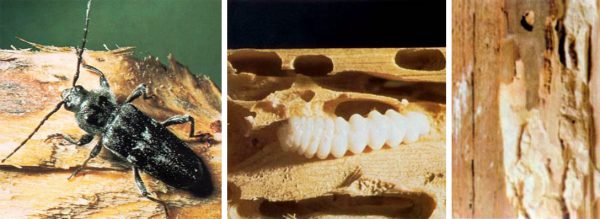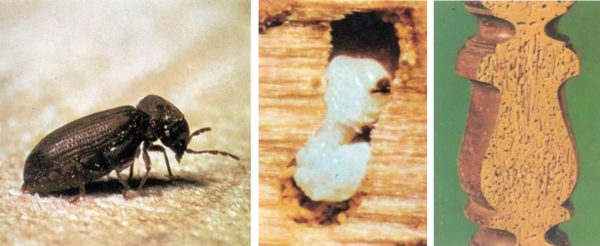Desctructive agents of wood:
mushrooms, xylophages saprophyte insects, marine invertebraes
The destructive agents that cause the most damage to wood are fungi, xilofagi saprophyte insects and marine invertebrates.
The technology applied to I.S.V.E. autoclaves aims to kerb the action of these organisms.
Fungi
Fungi are lower vegetable organisms without chlorophyll that feed on already elaborated organic material. This material may be the remains of organisms which had at one time been alive (in this case the Fungi are the so-called Saprophytes) or an integral part of living organisms (in this case the Fungi are Parasites). The importance of fungi in the wood sector is particularly relevant because they cause the destruction and disruption in the wood.
Wood cavity fungi
In order for these fungi to develop the wood must have a humidity level of over 20%.
- Basidiomycetes cavity fungi: are fungi which when they attack the cellulose cause a loss in size of the wood, together with the formation of prism or cube shaped soft cracks, so soft they can be squashed with the fingers. The development area of the fungi becomes brown, thus the name brown or destructive cavities.
Should the attack by basidiomycetes not be limited only to the cellulose but also attack the lignin, the colour of the wood becomes lighter than the healthy material and is reduced to a whitish fibrous mass (white or corrosive cavities). - Deuteromycetes soft cavity fungi: fungi that cause a type of cavity characterised by softening of the surface of the wood, although it can also cause deep cavities. These fungi need a higher humidity level than the one required for basidiomycetes. They are particularly important for wood that is in contact with the ground or water.

spreading of the “dark spot” fungus called “soft cavities”
which will gradually destroy the structure of the wood
making it similar to a brittle sponge.
Colouring fungi
They cause the bluing and mildew on installed wood. These fungi may cause concern only from the point of view of aesthetics, spoiling in some cases decorative panelling.
- Bluing fungi: they cause permanent colouring from blue to black and at various depths, above all in the alburnum of certain wood. Attacks by these fungi do not impair the mechanical properties of the wood, but may increase the level of permeability.

Action of blue fungus that during its development
succeeds in breaking through the film of coating and reach the surface
- Mildews: fungi which appear as spots in various colours on the surface of damp wood and which can appear only when the humidity on the surface of the wood is over 20%. This condition appears when there is high relative humidity or condensation from steam. The attack by mildew does not have an important influence on the mechanical properties of the wood but which gives the wood an unwanted and unacceptable appearance. These fungi are not specific to wood and may appear on any material where humidity is high.
The Xilophages Saprophyte insects
Beetles
Insects which fly and lay their eggs in the pores and cracks in wood. The larva causes the most serious damage, by burrowing internal galleries in the installed material. They are present throughout Europe, but attacks vary greatly depending on the geographic area. The most important are Hylotrupes bajulus, Anobium punctatum and Lyctus brunneus. There are many other insects of less importance, which destroy the wood; among which, for example, are Hesperophanes and Xestobium rufovillosum.
- Hylotrupes bajulus (House Longhorn): is undoubtedly one of the worst enemies of installed wood, in particular conifers, and the damage caused by the larva is very serious. It is present up to an altitude of about 2,000-m, not so widespread in the North and Northwest of Europe. The vitality of this insect depends on the temperature and humidity of the air. The incubation period for the eggs may be from 5 to 9 days at a temperature of 31.5°C and at humidity level between 90 and 95% or 48 days at a temperature of 16.6°C and environmental humidity at 18% (the latter condition being very unfavourable). The larvae burrow galleries in particular in the alburnum which become full of gnawed waste causing serious structural damage to the wood which can lose all its structure and solidity.

- Anobium punctatum (Furniture woodworm): is particularly widespread in maritime climates and wherever there is high humidity. It attacks in particular timber or installed wood of conifers or hardwood indifferently, affecting the alburnum and the duramen. The larvae burrow galleries with coarse gnawed waste mixed with excrement. Even if heavily attacked the wood does not completely lose its resistance and the structure remains recognisable.

- Xestobium rufovillosum (Death-watch beetle): attacks preferably timber or already installed wood, of various hardwoods (Oak, Elm, Walnut, Ontano, Poplar) but which is fairly humid, or old lopped decaying willow trees. The damage caused by Xestobium is the same as the damage caused by Anobium. Its importance is felt in particular in the structures in old buildings throughout most of Europe.
- Lyctus brunneus (Lyctus): in the past it was given little importance,but the damage it causes in the installed enclosures and furniture is now considered very serious. The larvae which breeds at its best in very humid wood, attacks all indigenous Hardwood with soft wood and with large vessels, plus the alburnum of the hard species, in particular Oak. The only species that seems to be immune are Popular, Beech and Birch, whereas the Eucalyptus trees are very vulnerable. If the infestation is particularly strong, the whole mass of wood is transformed into a solid compressed gnawed waste where the structure of the texture is no longer recognisable. The Lyctus brunneus is the most common in Italy.

- Hesperophanes sp.p.: a species common to Central and South Europe. The wood that suffers most is: Cerro, Robinia, Beech, Popular, Walnut and Chestnut. The females usually lay their eggs in the nooks and cracks of installed wood such as framework for roofs, furniture, wooden floors and all types of frames. The damage caused by the larvae can be very serious because it involves the structure and mechanical resistance of the part without any possibility of repairing. It is also very difficult to diagnose.
Termites
Social insects divided up into various families. The most dangerous species for buildings are those which live underground, mainly Reticulitermes lucifugus and Reticulitermes santonensis.
In Europe termites can be found only in certain limited geographical areas; they are present in Italy throughout the whole peninsula and on the islands. In these areas, the use of wood preservants in the fight against termites is integrated by the use of other protective means, for example for floors, for foundation work and walls. The danger of the attacks stems from the fact that, as their activity is hidden from the light, a superficial inspection will not reveal their presence. They always respect the external surface of the pieces of wood so that the alarm (always to late) is given by some beam or frame collapsing. The infection is by this time widespread.
Marine invertebrates
Marine organisms
A name given mainly to marine invertebrates such as Limnoria sp.p. and Teredo sp.p., which require a certain level of salt in the water and which burrow large tunnels and cavities in the wood.
These organisms can seriously damage both fixed and floating structures.
Bibliography
- G. GIORDANO – TECNOLOGIA DEL LEGNO – UTET
- CEN (Comitato Europeo di Normalizzazione) – NORMA EUROPEA EN 335
Data, characteristics and illustrations are purely indicative.
I.S.V.E. Srl reserves the right to make the changes it deems most appropriate.



